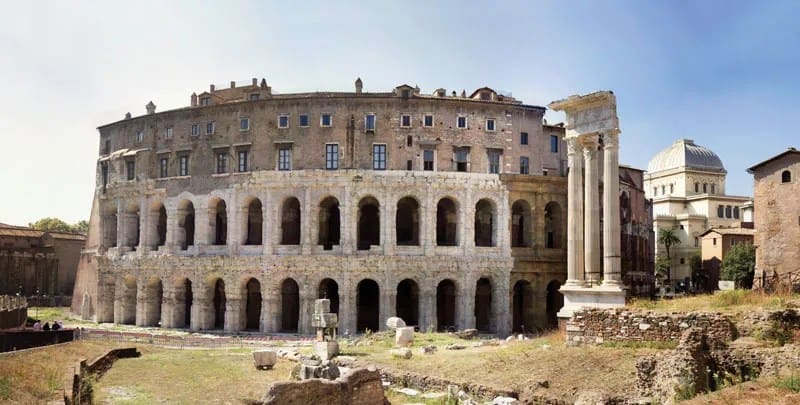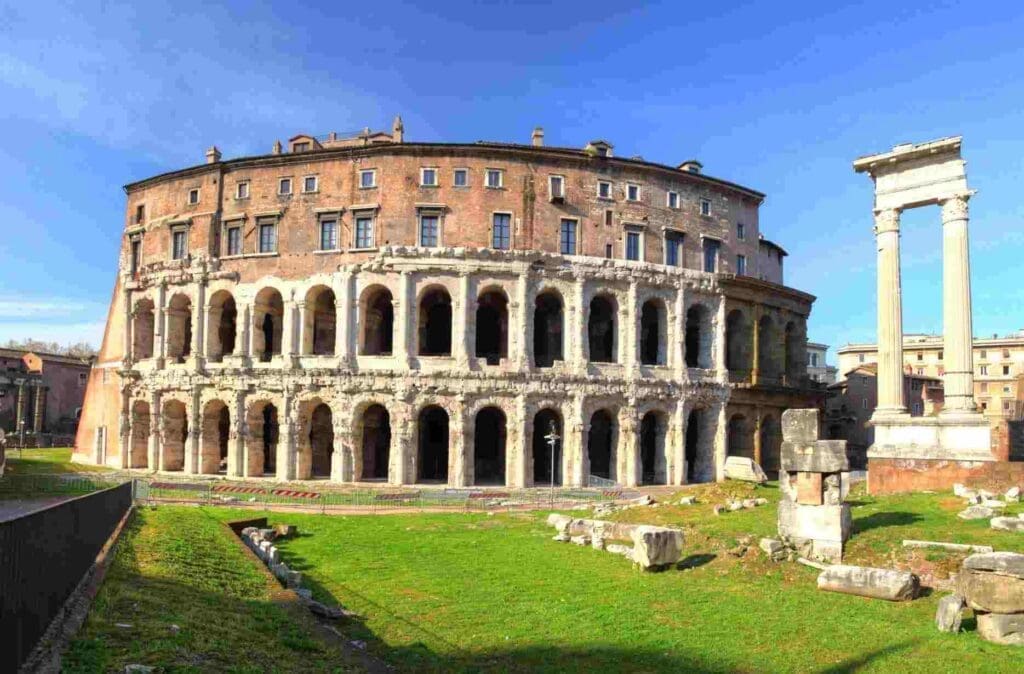Fun Facts About The Theatre of Marcellus
The Theatre of Marcellus is a remarkable testament to ancient Roman architecture and history. Here are some fascinating details about this iconic structure:
1. Historical Significance
- Age: Commissioned by Emperor Augustus in 13 BCE, the Theatre of Marcellus is over 2000 years old.
- Named After Marcellus: It was named in honor of Augustus’ nephew, Marcellus, who was designated as his heir but died young.
- Predecessor to the Colosseum: It was one of the earliest large stone theaters in Rome and influenced the design of the later Colosseum.
2. Architectural Marvel
- Size and Capacity: Originally, it could seat up to 20,000 spectators, making it the largest theater in Rome during its time.
- Design: The theater was semi-circular, a common design for Roman theaters, featuring three tiers of seating.
- Materials: The lower level was constructed with travertine stone, while the upper levels used tufa and brick.
3. Usage Throughout History
- Entertainment: Initially, it hosted plays, musical performances, and other public spectacles.
- Medieval Fortification: After the fall of the Roman Empire, it was repurposed as a fortress by the Fabii family.
- Renaissance Adaptation: In the 16th century, it was transformed into a palace by the Savelli family, who built apartments atop the ruins.
4. Current Use and Preservation
- Modern Apartments: The upper terraces have been converted into residential apartments, blending modern living with ancient architecture.
- Cultural Events: The lower levels are used for concerts and performances, maintaining its connection to the arts.
- Tourist Attraction: It remains a popular site for visitors interested in Rome’s rich history.
5. Comparison with Other Ancient Theaters
- Larger than Pompey’s Theatre: Although the Theatre of Pompey was the first permanent theater in Rome, it was smaller and less grand compared to the Theatre of Marcellus.
- Influence on the Colosseum: Many architectural features from the Theatre of Marcellus, including its use of arches and columns, were later incorporated into the design of the Colosseum.
6. Architectural Features
- Arches and Columns: The theater’s exterior is adorned with arches supported by engaged columns in Doric and Ionic styles, characteristic of Roman architecture.
- Circular Structure: The theater’s arc screen and circular design enhanced acoustics and visibility for the audience, reflecting the sophistication of Roman engineering.
The Theatre of Marcellus stands as a vivid reminder of Rome’s architectural ingenuity and its ability to adapt and repurpose structures through the centuries.

Fun facts about the Theatre of Marcellus?
- Fun facts About The Theatre of Marcellus is more than 2000 years old served as the largest theatre in ancient Rome and the design was replicated by the colosseum.
The theatre was built by Marcellus, but what happened to it overtime?
- It was converted into a fort in the middle Ages and then turned into a palace and the present day upper floors are apartments.
What theatre was the largest one of the ancient Rome?
- Marcellus theatre was one of the largest theatres in ancient Rome, and was constructed by the pontiff M. Vinicius between 17 and 11 BC.
What was the role of Theatre of Marcellus?
- It being also employed as the venue for the performances of plays, concerts and so on and later as the fortress and the palace.
Fun facts about the theatre of marcellus: Little-known information about the Theater of Marcellus
- Marcellus was Augustus’ nephew and the design of the Marcellus was used as reference to design the Colosseum.
- Theatre of Marcellus architecture
- It appears that the architecture of theater was semicircular, the same as in many Roman theaters; it was built with concrete and stone.
What is the use of theatre in the modern day world according to the Theatre of Marcellus?
- It is currently used mainly for holding outdoor concerts as well as performance and it also contains private apartments.
Fur printing and textiles: A home to the Teatro di Marcello NYT
- The theatre is also sightseer cultural icon in Rome and has been posted severally in several literature due to its historical presentation.
- Theatre of Marcellus apartments
- The upper floors that were once used as theatre have since been turned into residential spaces.
- In relation with the cultural developments, when was the Theater of Pompey constructed?
- The Theater of Pompey was constructed in 55BC which makes it older that the Theatre of Marcellus.

Fun facts about the theatre of marcellus: FAQs
1. How old is the Theatre of Marcellus?
A. The Theatre of Marcellus was inaugurated in 13 BCE, making it over 2,000 years old.
2. What was the Theatre of Marcellus used for?
A. Initially used for public entertainment like plays and music performances, it was later repurposed as a fortress and then adapted into a palazzo.
3. Is the Theatre of Marcellus still used today?
A. Yes, it is used for cultural events and houses private apartments in its upper sections.
4. What materials were used in constructing the Theatre of Marcellus?
A. The theater was built using travertine stone for the lower levels and tufa and brick for the upper levels.
5. What is unique about the Fun facts About The Theatre of Marcellus’s design?
A. It features a semi-circular seating arrangement and a combination of Doric and Ionic columns on its exterior.
6. Who was the Theatre of Marcellus named after?
A. It was named after Marcus Claudius Marcellus, the nephew of Emperor Augustus.
7. How does the Theatre of Marcellus compare to the Colosseum?
A. The Theatre of Marcellus served as a precursor and architectural inspiration for the Colosseum.
8. What happened to the Theatre of Marcellus during the Middle Ages?
A. It was repurposed as a fortress by the Fabii family.
9. Can you visit the Theatre of Marcellus today?
A. Yes, it is open to tourists and still hosts cultural events.
The Theatre of Marcellus is one of those ancient arts which remain timeless and offer Rome’s architectural marvel and rich historical significance.





0 Comments